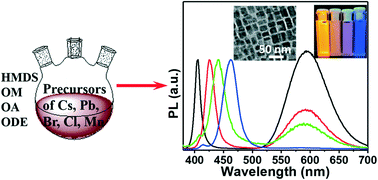Hexamethyldisilazane-assisted Mn2+ doping of perovskite nanocrystals under ambient conditions†
Abstract
Doping Mn2+ ions into lead halide perovskite (LHP) nanocrystals (NCs) has attracted great attention in the optoelectronic fields due to the stability enhancement and unique dual-color emission characteristics arising from the energy transfer from the LHP host to the dopants (i.e., Mn2+ ions). Herein, we report a facile and scalable synthetic protocol for Mn2+-doped CsPbCl3 and CsPbBrxCl3−x nanoplates via a one-pot room-temperature (RT) procedure in the presence of hexamethyldisilazane (HMDS). It is noteworthy that both HMDS and Mn2+ ions play a critical role in triggering the crystallization of the Mn-doped LHP NCs under ambient conditions by functioning as a passivation agent with Lewis base groups that coordinate with Pb2+ ions. The optical properties including the emission wavelength and the relative PL intensity of the band-to-band emission and the Mn2+ emission are tuned by changing the amount of HMDS and the precursor ratios Mn : Pb and Br : Cl. It is interesting that the representative Mn-doped CsPbCl3 NCs displayed enhanced thermal stability, which was confirmed by the observation that the emission intensity of the sample annealed below 95 °C for 2 h increases compared with that of the fresh sample. Ion exchanges between not only Cl−, Br− and I− but also Mn2+ and Pb2+ are also investigated.



 Please wait while we load your content...
Please wait while we load your content...